-
Paper Information
- Previous Paper
- Paper Submission
-
Journal Information
- About This Journal
- Editorial Board
- Current Issue
- Archive
- Author Guidelines
- Contact Us
American Journal of Geographic Information System
p-ISSN: 2163-1131 e-ISSN: 2163-114X
2019; 8(2): 89-95
doi:10.5923/j.ajgis.20190802.04

Validation of Global TEC Mapping Model Based on Spherical Harmonic Expansion towards TEC Mapping over Egypt from a Regional GPS Network
Alaa A. Elghazouly1, Mohamed I. Doma1, Ahmed A. Sedeek2, Mostafa M. Rabah3, Mostafa A. Hamama4
1Civil Department, Faculty of Engineering, Menoufia University, Egypt
2Civil Department, EL Behira Higher Institute of Engineering and Technology, El Behira, Egypt
3Civil Department, Benha Faculty of Engineering, Benha University, Egypt
4Faculty of Petroleum & Mining Engineering, Suez University, Suez, Egypt
Correspondence to: Mohamed I. Doma, Civil Department, Faculty of Engineering, Menoufia University, Egypt.
| Email: |  |
Copyright © 2019 The Author(s). Published by Scientific & Academic Publishing.
This work is licensed under the Creative Commons Attribution International License (CC BY).
http://creativecommons.org/licenses/by/4.0/

Unlike the interpolation process of Total Electron Content (TEC) maps made by Ionospheric Associate Analysis Centers (IAAC) over areas have no International GNSS Service (IGS) stations, A TEC mapping tool with a temporal resolution of 1 h based on GPS dual frequency observations was developed. This tool was written under MATLAB environment and can be used globally to produce GIMs from local GPS networks in several areas with low number of IGS stations or without. As the geomagnetic storm field affect directly on the TEC, three stormy days and other three quiet days were chosen for validating the developed model. The estimated TEC resulted from the model firstly was compared with Center for Orbit Determination in Europe (CODE) TEC results using the RINEX data of ten Eurobian IGS stations. The comparison of the results shows a convergence between CODE and GTM estimated TEC. The maximum differences were 2.52 TECU and 1.31 TECU for the stormy and quiet days, respectively. Then the new models was used to generate TEC maps of Egypt using a regional network with interval of 1 h have a high temporal resolution compared to global ionosphere maps which are produced by several analysis centers.
Keywords: Ionosphere, Geomagnetic storm, TEC mapping
Cite this paper: Alaa A. Elghazouly, Mohamed I. Doma, Ahmed A. Sedeek, Mostafa M. Rabah, Mostafa A. Hamama, Validation of Global TEC Mapping Model Based on Spherical Harmonic Expansion towards TEC Mapping over Egypt from a Regional GPS Network, American Journal of Geographic Information System, Vol. 8 No. 2, 2019, pp. 89-95. doi: 10.5923/j.ajgis.20190802.04.
Article Outline
1. Introduction
- Ionosphere, part of the upper atmosphere of Earth extending from 60 km to 1500 km above the Earth’s surface, is a highly changing environment, both spatially and temporally. The variability of this environment depends mainly on Earth's rotation, season, solar and geomagnetic activity [1]. Many researches show that the ionospheric attitude during geomagnetic storms is varied from its normal attitude [2]. The geomagnetic storm makes thermospheric winds, inspires electric currents and changes the structure in the upper atmosphere. Each of them can produce a non-regular variation in the photoionization, recombination, and transport processes causing an irregular change in the electron concentration of the ionosphere. Some main effects are the significant change in the neutral wind circulation and atmospheric composition affecting the rate of production and loss of ionization, which caused the serve changes in TEC [3].The significance of oversight the ionosphere layer lies in contributing useful understanding to the physics behind different space weather phenomena [4, 5, 6], in providing valuable insights into the possible causes of natural and man-made hazardous events such as earthquakes [7, 8, 9, 10]. Since its premier operation in 1978, GPS has certain to be an influential sensor for monitoring the ionosphere with wide spatial coverage and high temporal resolution [11, 12, 13, 14, 15]. The vertical Total Electron Content (vTEC) is usually the most widely used in presenting values of global ionosphere content density [16, 17]. IGS orderly produce the snapshots of the global vTEC in the form of Global Ionosphere Maps (GIMs) [14, 18]. GIMs can extended ionospheric TEC with 5° and 2.5° spatial resolution in longitude and latitude, respectively, and a temporal resolution of few minutes to several hours in real-time, rapid and final modes. Although the real-time GIM produces have been offered by the IGS, users now can only outlet the rapid and final GIMs with a latency of few days [19]. GIM in IONEX format can be downloaded from IGS analysis center site ‘ftp://cddis.gsfc.nasa.gov/gps/products/ionex/’ in TECU units where 1 TECU = 1016 el/m2. There are four IGS IAACs have been frequently participating GIM products to the IGS ionosphere working group since 1998, these centers including CODE, Universitat Politècnica de Catalunya/IonSAT (UPC), Jet Propulsion Laboratory (JPL), European Space Operations Center of European Space Agency (ESA) [13, 18, 20, 21].This study aims to have an accurate TEC mapping tool that can use local stations dual frequency GPS observations to produce TEC values with a temporal resolution of 1 h. This tool was written under MATLAB environment and can be used globally to produce GIMs from local GPS networks in several areas with low number of IGS stations or without. Firstly, values of TEC from this tool were validated using IGS stations and CODE’s GIMs. Seven regional stations GPS observations distributed over Egypt were used to estimate TEC values over Egypt.
2. Ionospheric Model
- As ionosphere delay is frequency dependent, it can be obtained using dual frequency observations. The pseudorange measurements observation equations for dual frequency GPS can be expressed as [20]:
 | (1) |
 | (2) |
 | (3) |
 | (4) |
 0.9782 [24]),
0.9782 [24]),  is elevation angle at the ground station.The ionospheric model based on the Spherical Harmonic can be expressed as [24]:
is elevation angle at the ground station.The ionospheric model based on the Spherical Harmonic can be expressed as [24]: | (5) |
 is regularization Legendre series and
is regularization Legendre series and  and
and  are the estimated spherical harmonics coefficients. The height of the ionospheric single layer model in the current study is set to equal 506.7 km, as used by CODE, and 4-order and 4-degree Spherical Harmonic expansion are used to establish the model. The observations with the elevation angle below 10° are masked and removed. In case the GPS raw data do not include the P1 observation (Non-cross correlation receiver type), the P1-C1 correction provided by IGS to modify the C1 observation is used, and the observation combination between P1 and P2 can be obtained. As there is a huge number of observations, the spherical harmonic coefficient and the DCB of both P1 and P2 can be estimated according to the weighted least square method. The used weight function is based upon a function of elevation angle. Finally, the vTEC and DCB can be determined.
are the estimated spherical harmonics coefficients. The height of the ionospheric single layer model in the current study is set to equal 506.7 km, as used by CODE, and 4-order and 4-degree Spherical Harmonic expansion are used to establish the model. The observations with the elevation angle below 10° are masked and removed. In case the GPS raw data do not include the P1 observation (Non-cross correlation receiver type), the P1-C1 correction provided by IGS to modify the C1 observation is used, and the observation combination between P1 and P2 can be obtained. As there is a huge number of observations, the spherical harmonic coefficient and the DCB of both P1 and P2 can be estimated according to the weighted least square method. The used weight function is based upon a function of elevation angle. Finally, the vTEC and DCB can be determined.3. Data Used
- As mentioned before, the main objective of the current study is to validate the GTM resulted from the developed model with related results produced by CODE’s GIMs. After the validity process, the developed modes was used to estimate TEC using regional GPS receivers network like Egypt network used here. To check the performance of the model in different Circumstances of TEC variation, TEC values of selected area from 0° to 20° longitude and from 42.5° to 55° latitude will be estimated in stormy and quiet days. Figure 1 shows the data that was used for validation process. This data is produced by 10 IGS stations namely, BRUX, FFMJ, GOPE, HUEG, LEIJ, OBE4, POTS, PTBB, WSRT and WTZZ.
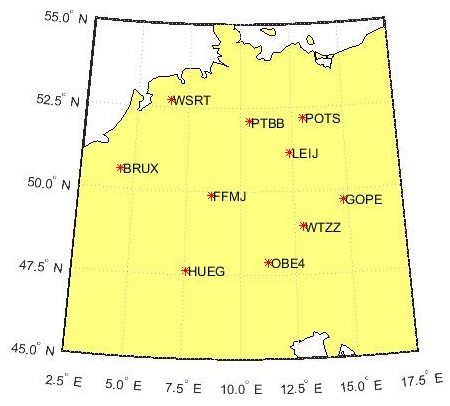 | Figure 1. Distribution of IGS stations |
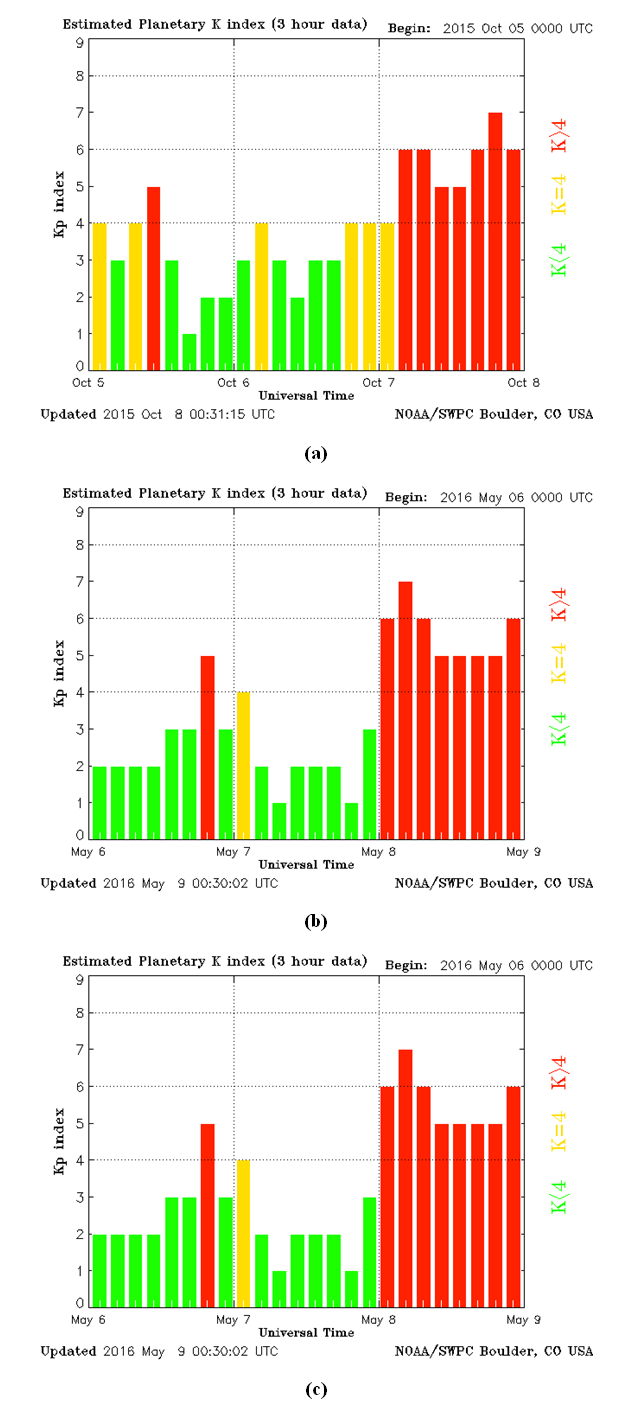 | Figure 2. The Kp values of the selected stormy days, (a) at 7-10-2015, (b) at 8-5-2016 and (c) at 8-9-2017 [26] |
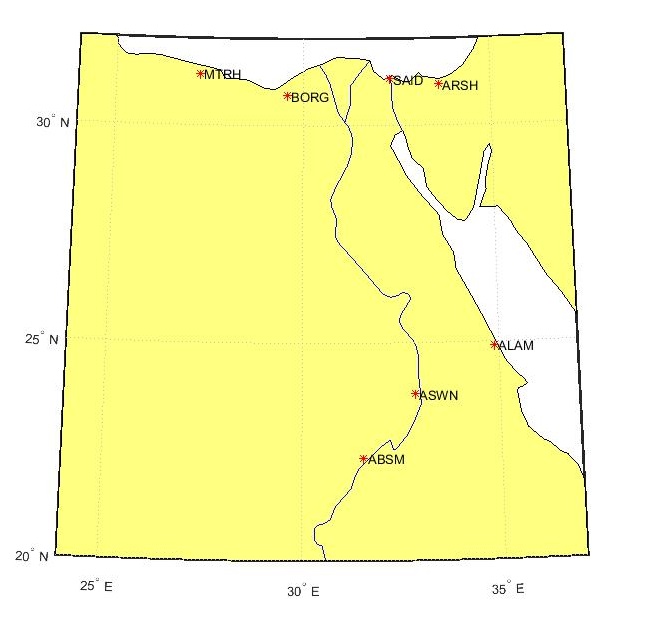 | Figure 3. Distribution of regional GPS stations of Egypt |
4. Validation Results
- The model is applied to the mentioned above groups of days. Table 1 and table 2 give the values of mean TEC values of CODE and mean values of the output TEC of GTM model every 1 h in TECU (TEC Unit= 1016 electron/m3, 1 TECU= 0.163 m and 0.267 m in L1 and L2 frequencies respectively (Ovstedal, 2002)) for the selected area for stormy and quiet days. Also, the table gives the Mean and Standard Deviation of the Mean (SDM) of the TEC results for each hour that used often to reveal the amount of variation or dispersion of a set of data values. Mean and SDM equations are described by the following functions.
 | (6) |
 | (7) |
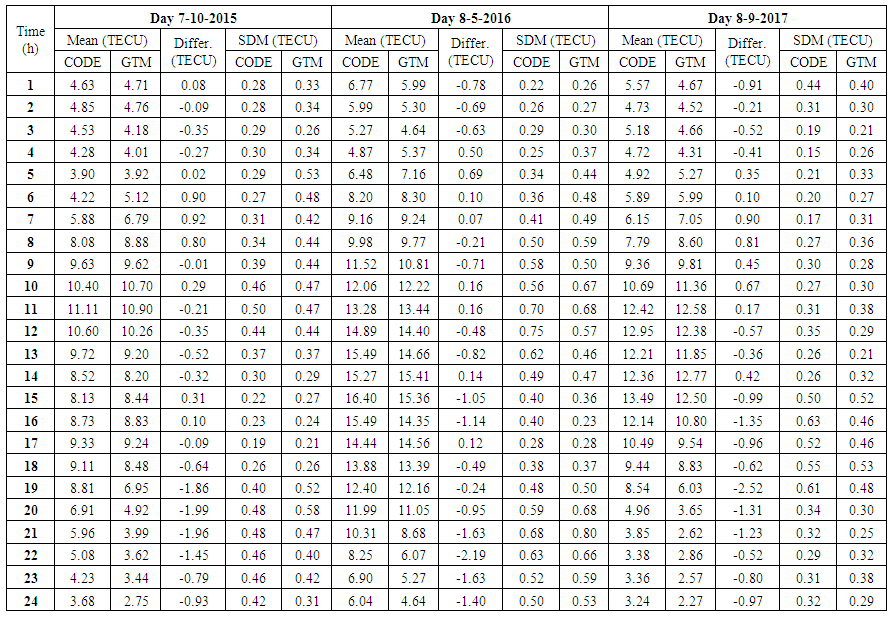 | Table 1. Statistical values of CODE and GTM TEC results for the selected stormy days |
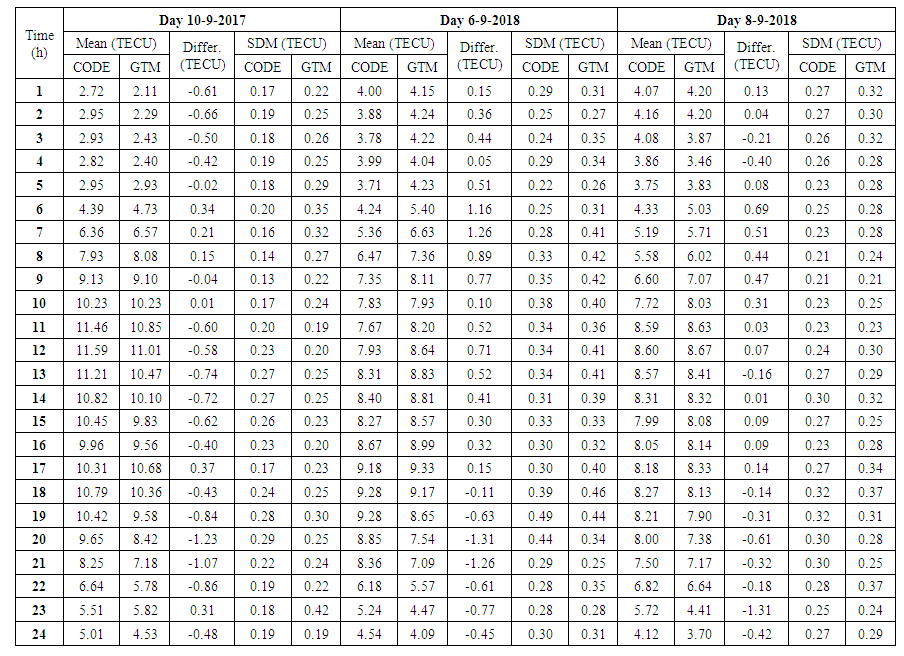 | Table 2. Statistical values of CODE and GTM TEC results for the selected quiet days |
 | Table 3. Statistical values of CODE and GTM TEC results for day 7-6-2015 |
5. Egypt TEC Mapping
- After the make sure of the Convergence of results of GTM with those of CODE-one of IAAC-it is time to estimate TEC values over Egypt from its regional 24h working receivers. Firstly, TEC values are estimated using GTM and then ARCMap 10.6 was used to draw TEC maps. Borders of the maps are from 24° to 37° longitude and from 20° to 32° latitude with 1h temporal resolution of day 7-6-2015. The following figure 4 shows these TEC maps. The shown 24 TEC maps (figure 4) give a snap shot of the ionosphere distribution over Egypt country borders every 1 hour. Maps show near equally distribution of TEC over Egypt in all time of that day except the afternoon hours from 12h to 16h. That can be observed from the divergence of contour lines of in steady hours and convergence of them in afternoon hours. The highest values of contour TEC values are calculated from real GPS observation not interpolated points.
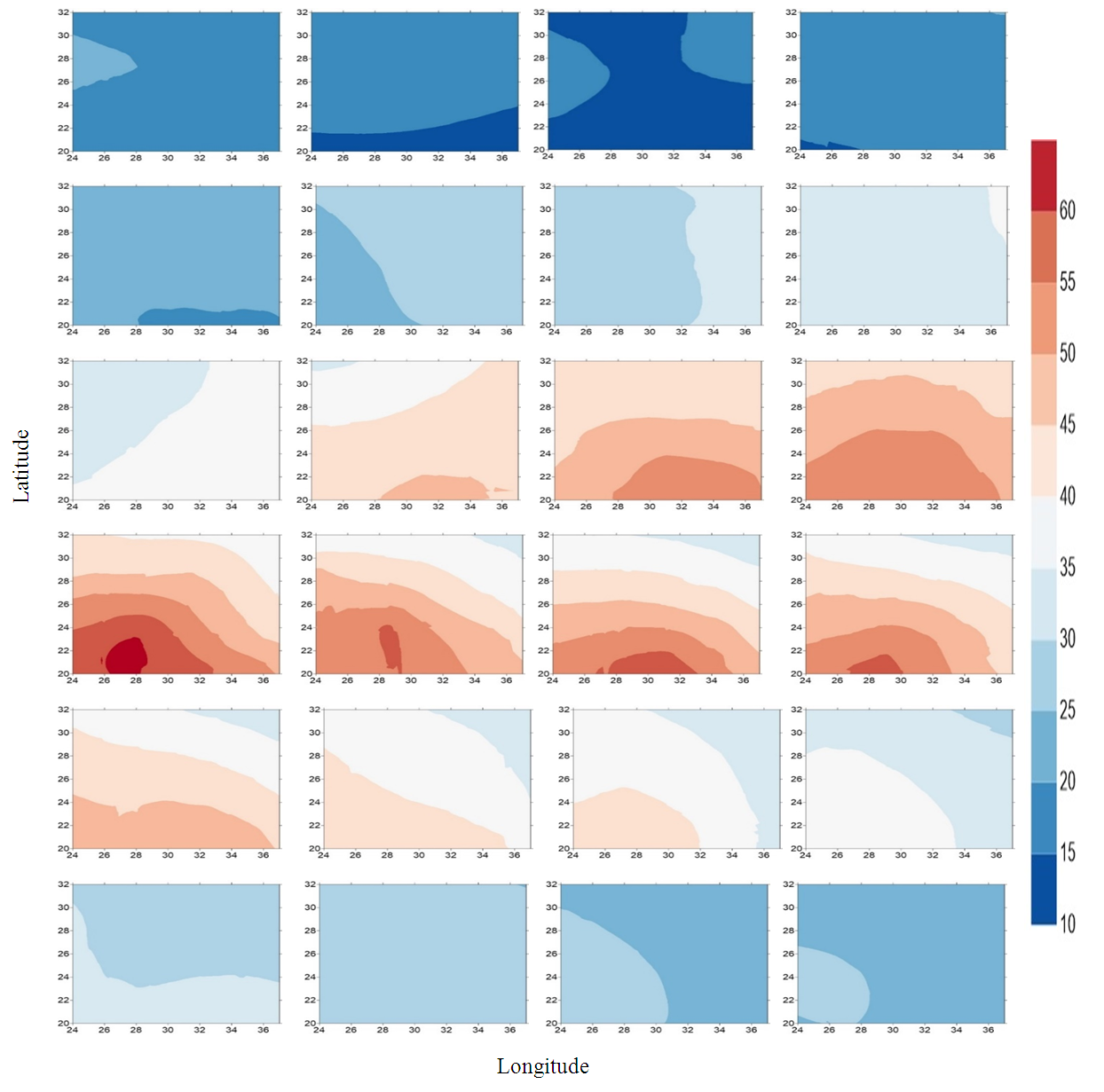 | Figure 4. TEC maps over Egypt country start from 1h to 24h of day 7-6-2015 |
6. Conclusions
- In this study, a global TEC mapping model was developed to monitor ionosphere changing with 1 h temporal resolution based on dual frequency GPS receivers. The spherical harmonic expansion technique was used as the mathematical model for the global ionosphere model with degree and order of 4. Statistical values of our model are very close to those of CODE-one of the international ionosphere ACs that usually provide the TEC map. This model shows good results in both stormy and quiet days. Using 1 h maps interval is more useful for quickly recognize the ionosphere variation, especially in stormy days. The GTM model can be used regionally to estimate the ionospheric delay of the pseudo range.
 Abstract
Abstract Reference
Reference Full-Text PDF
Full-Text PDF Full-text HTML
Full-text HTML